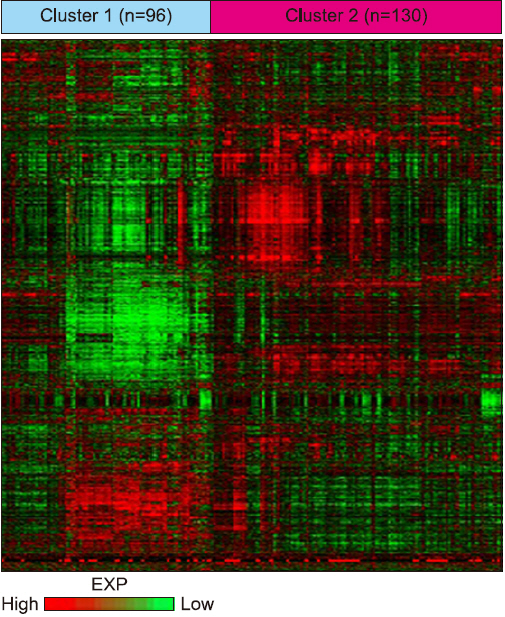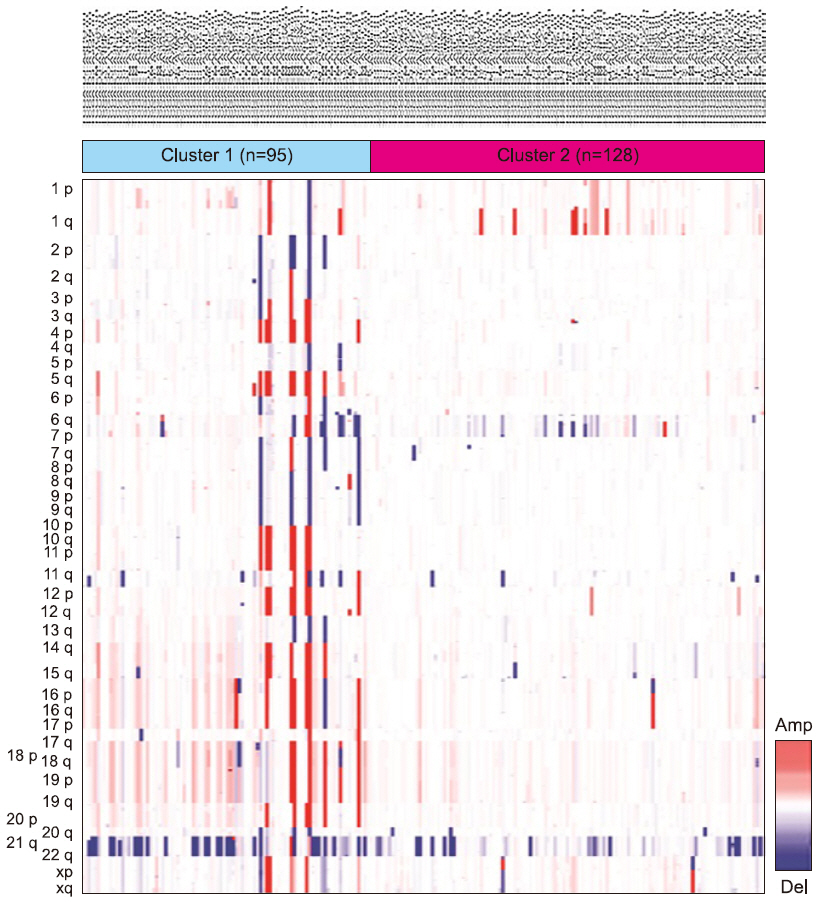Int J Thyroidol.
2020 May;13(1):1-12. 10.11106/ijt.2020.13.1.1.
The Significance of Transcriptomic Signatures in the Multifocal Papillary Thyroid Carcinoma: Two mRNA Expression Patterns with Distinctive Clinical Behavior from The Cancer Genome Atlas (TCGA) Database
- Affiliations
-
- 1Division of Endocrinology and Metabolism, Department of Internal Medicine, Chungnam National University College of Medicine, Korea
- 2Department of Otolaryngology-Head and Neck Surgery, Chungnam National University College of Medicine, Korea
- 3Daejeon, Department of Otolaryngology-Head and Neck Surgery, Hallym University College of Medicine, Seoul, Korea
- KMID: 2502254
- DOI: http://doi.org/10.11106/ijt.2020.13.1.1
Abstract
- Background and Objectives
The association between multifocal papillary thyroid carcinoma (PTC) and tumor aggressiveness remains controversial. The aim of study is to evaluate molecular subtypes of multifocal PTCs using multiplatform genomic analysis.
Materials and Methods
Statistical analysis and genomic analysis were performed for gene expression data and clinical data of multifocal PTCs in The Cancer Genome Atlas data. Clinicopathologic findings, recurrence-free survival (RFS), copy number alteration and somatic mutation status in patients in relation to molecular subtypes were analyzed.
Results
Multiplatform genomic analysis revealed that multifocal PTCs (n=226) were divided into two distinct molecular subgroups. Participants in cluster 2 showed significantly increased risk of extrathyroidal extension, lymph node metastasis, and BRAFV600E mutation compared to patients in cluster 1. To exclude the effect of BRAF mutation and RAS mutation on tumor aggressiveness, we compared clinical parameters between two clusters in patients without BRAF or RAS mutation. Cluster 2 showed significantly higher risk of lymph node metastasis compared to cluster 1.
Conclusion
Multifocal PTC has two distinct molecular subtypes with distinctive clinical behaviors. Our data suggested the clinical implications of the transcriptomic signature to predict clinical outcomes of multifocal PTC.
Figure
Reference
-
1. Hundahl SA, Fleming ID, Fremgen AM, Menck HR. 1998; A National Cancer Data Base report on 53,856 cases of thyroid carcinoma treated in the U. S. 1985-1995 [see commetns]. Cancer. 83(12):2638–48. DOI: 10.1002/(SICI)1097-0142(19981215)83:12<2638::AID-CNCR31>3.0.CO;2-1. PMID: 9874472.2. Joseph KR, Edirimanne S, Eslick GD. 2018; Multifocality as a prognostic factor in thyroid cancer: A meta-analysis. Int J Surg. 50:121–5. DOI: 10.1016/j.ijsu.2017.12.035. PMID: 29337178.
Article3. Kim HJ, Sohn SY, Jang HW, Kim SW, Chung JH. 2013; Multifocality, but not bilaterality, is a predictor of disease recurrence/persistence of papillary thyroid carcinoma. World J Surg. 37(2):376–84. DOI: 10.1007/s00268-012-1835-2. PMID: 23135422.
Article4. Park SY, Park YJ, Lee YJ, Lee HS, Choi SH, Choe G, et al. 2006; Analysis of differential BRAF(V600E) mutational status in multifocal papillary thyroid carcinoma: evidence of independent clonal origin in distinct tumor foci. Cancer. 107(8):1831–8. DOI: 10.1002/cncr.22218. PMID: 16983703.5. Iacobone M, Jansson S, Barczynski M, Goretzki P. 2014; Multifocal papillary thyroid carcinoma--a consensus report of the European Society of Endocrine Surgeons (ESES). Langenbecks Arch Surg. 399(2):141–54. DOI: 10.1007/s00423-013-1145-7. PMID: 24263684.
Article6. Wang W, Su X, He K, Wang Y, Wang H, Wang H, et al. 2016; Comparison of the clinicopathologic features and prognosis of bilateral versus unilateral multifocal papillary thyroid cancer: An updated study with more than 2000 consecutive patients. Cancer. 122(2):198–206. DOI: 10.1002/cncr.29689. PMID: 26506214.
Article7. Amin A, Younis G, Sayed K, Saeed Z. 2015; Cervical lymph node metastasis in differentiated thyroid carcinoma: does it have an impact on disease-related morbid events? Nucl Med Commun. 36(2):120–4. DOI: 10.1097/MNM.0000000000000234. PMID: 25356622.8. Blanchard C, Brient C, Volteau C, Sebag F, Roy M, Drui D, et al. 2013; Factors predictive of lymph node metastasis in the follicular variant of papillary thyroid carcinoma. Br J Surg. 100(10):1312–7. DOI: 10.1002/bjs.9210. PMID: 23939843.
Article9. Pinyi Z, Bin Z, Jianlong B, Yao L, Weifeng Z. 2014; Risk factors and clinical indication of metastasis to lymph nodes posterior to right recurrent laryngeal nerve in papillary thyroid carcinoma: a single-center study in China. Head Neck. 36(9):1335–42. DOI: 10.1002/hed.23451. PMID: 23955992.
Article10. Singhal S, Sippel RS, Chen H, Schneider DF. 2014; Distinguishing classical papillary thyroid microcancers from follicular-variant microcancers. J Surg Res. 190(1):151–6. DOI: 10.1016/j.jss.2014.03.032. PMID: 24735716. PMCID: PMC4053495.
Article11. Konturek A, Barczynski M, Nowak W, Richter P. 2012; Prognostic factors in differentiated thyroid cancer--a 20-year surgical outcome study. Langenbecks Arch Surg. 397(5):809–15. DOI: 10.1007/s00423-011-0899-z. PMID: 22350610. PMCID: PMC3349847.
Article12. Ahn D, Sohn JH, Kim JH, Shin CM, Jeon JH, Park JY. 2013; Preoperative subclinical hypothyroidism in patients with papillary thyroid carcinoma. Am J Otolaryngol. 34(4):312–9. DOI: 10.1016/j.amjoto.2012.12.013. PMID: 23357595.
Article13. Cancer Genome Atlas Research Network. 2014; Integrated genomic characterization of papillary thyroid carcinoma. Cell. 159(3):676–90. DOI: 10.1016/j.cell.2014.09.050. PMID: 25417114. PMCID: PMC4243044.14. Simon R, Lam A, Li MC, Ngan M, Menenzes S, Zhao Y. 2007; Analysis of gene expression data using BRB-ArrayTools. Cancer Inform. 3:11–7. DOI: 10.1177/117693510700300022. PMID: 19455231. PMCID: PMC2675854.15. Eisen MB, Spellman PT, Brown PO, Botstein D. 1998; Cluster analysis and display of genome-wide expression patterns. Proc Natl Acad Sci U S A. 95(25):14863–8. DOI: 10.1073/pnas.95.25.14863. PMID: 9843981. PMCID: PMC24541.
Article16. Kim SJ, Myong JP, Jee HG, Chai YJ, Choi JY, Min HS, et al. 2016; Combined effect of Hashimoto's thyroiditis and BRAF(V600E) mutation status on aggressiveness in papillary thyroid cancer. Head Neck. 38(1):95–101. DOI: 10.1002/hed.23854. PMID: 25213729.17. Bircan HY, Koc B, Akarsu C, Demiralay E, Demirag A, Adas M, et al. 2014; Is Hashimoto's thyroiditis a prognostic factor for thyroid papillary microcarcinoma? Eur Rev Med Pharmacol Sci. 18(13):1910–5. PMID: 25010622.18. Lee YK, Park KH, Park SH, Kim KJ, Shin DY, Nam KH, et al. 2018; Association between diffuse lymphocytic infiltration and papillary thyroid cancer aggressiveness according to the presence of thyroid peroxidase antibody and BRAF(V600E) mutation. Head Neck. 40(10):2271–9. DOI: 10.1002/hed.25327. PMID: 29935011.
Article19. Qu HJ, Qu XY, Hu Z, Lin Y, Wang JR, Zheng CF, et al. 2018; The synergic effect of BRAF(V600E) mutation and multifocality on central lymph node metastasis in unilateral papillary thyroid carcinoma. Endocr J. 65(1):113–20. DOI: 10.1507/endocrj.EJ17-0110. PMID: 29070763.20. Kimbrell HZ, Sholl AB, Ratnayaka S, Japa S, Lacey M, Carpio G, et al. 2015; BRAF testing in multifocal papillary thyroid carcinoma. Biomed Res Int. 2015:486391. DOI: 10.1155/2015/486391. PMID: 26448939. PMCID: PMC4584030.21. Giordano D, Gradoni P, Oretti G, Molina E, Ferri T. 2010; Treatment and prognostic factors of papillary thyroid microcarcinoma. Clin Otolaryngol. 35(2):118–24. DOI: 10.1111/j.1749-4486.2010.02085.x. PMID: 20500581.
Article22. Hay ID, Hutchinson ME, Gonzalez-Losada T, McIver B, Reinalda ME, Grant CS, et al. 2008; Papillary thyroid microcarcinoma: a study of 900 cases observed in a 60-year period. Surgery. 144(6):980–7. discussion 7–8. DOI: 10.1016/j.surg.2008.08.035. PMID: 19041007.
Article23. Lombardi CP, Bellantone R, De Crea C, Paladino NC, Fadda G, Salvatori M, et al. 2010; Papillary thyroid microcarcinoma: extrathyroidal extension, lymph node metastases, and risk factors for recurrence in a high prevalence of goiter area. World J Surg. 34(6):1214–21. DOI: 10.1007/s00268-009-0375-x. PMID: 20052467.
Article24. Xing M, Alzahrani AS, Carson KA, Viola D, Elisei R, Bendlova B, et al. 2013; Association between BRAF V600E mutation and mortality in patients with papillary thyroid cancer. JAMA. 309(14):1493–501. DOI: 10.1001/jama.2013.3190. PMID: 23571588. PMCID: PMC3791140.
Article25. Henke LE, Pfeifer JD, Ma C, Perkins SM, DeWees T, El-Mofty S, et al. 2015; BRAF mutation is not predictive of long-term outcome in papillary thyroid carcinoma. Cancer Med. 4(6):791–9. DOI: 10.1002/cam4.417. PMID: 25712893. PMCID: PMC4472201.26. Gouveia C, Can NT, Bostrom A, Grenert JP, van Zante A, Orloff LA. 2013; Lack of association of BRAF mutation with negative prognostic indicators in papillary thyroid carcinoma: the University of California, San Francisco, experience. JAMA Otolaryngol Head Neck Surg. 139(11):1164–70. DOI: 10.1001/jamaoto.2013.4501. PMID: 24030686.27. Kim HK, Lee I, Lee J, Chang HS, Soh EY, Park IS, et al. 2018; BRAF(wild) papillary thyroid carcinoma has two distinct mRNA expression patterns with different clinical behaviors. Head Neck. 40(8):1707–18. DOI: 10.1002/hed.25151. PMID: 29573027.28. Song YS, Lim JA, Park YJ. 2015; Mutation profile of well-differentiated thyroid cancer in Asians. Endocrinol Metab (Seoul). 30(3):252–62. DOI: 10.3803/EnM.2015.30.3.252. PMID: 26435130. PMCID: PMC4595348.
Article29. An JH, Song KH, Kim SK, Park KS, Yoo YB, Yang JH, et al. 2015; RAS mutations in indeterminate thyroid nodules are predictive of the follicular variant of papillary thyroid carcinoma. Clin Endocrinol (Oxf). 82(5):760–6. DOI: 10.1111/cen.12579. PMID: 25109485.
Article30. Oh KH, Jung KY, Baek SK, Woo JS, Cho JG, Kwon SY. 2017; Relation between RASSF1A methylation and BRAF mutation in thyroid tumor. Int J Thyroidol. 11(2):123–9. DOI: 10.11106/ijt.2018.11.2.123.
Article31. Mauer J, Denson JL, Bruning JC. 2015; Versatile functions for IL-6 in metabolism and cancer. Trends Immunol. 36(2):92–101. DOI: 10.1016/j.it.2014.12.008. PMID: 25616716.
Article32. Krawczyk CM, Holowka T, Sun J, Blagih J, Amiel E, DeBerardinis RJ, et al. 2010; Toll-like receptor-induced changes in glycolytic metabolism regulate dendritic cell activation. Blood. 115(23):4742–9. DOI: 10.1182/blood-2009-10-249540. PMID: 20351312. PMCID: PMC2890190.
Article33. Jovanovic L, Delahunt B, McIver B, Eberhardt NL, Grebe SK. 2008; Most multifocal papillary thyroid carcinomas acquire genetic and morphotype diversity through subclonal evolution following the intra-glandular spread of the initial neoplastic clone. J Pathol. 215(2):145–54. DOI: 10.1002/path.2342. PMID: 18393366.
Article34. Lin X, Finkelstein SD, Zhu B, Silverman JF. 2008; Molecular analysis of multifocal papillary thyroid carcinoma. J Mol Endocrinol. 41(4):195–203. DOI: 10.1677/JME-08-0063. PMID: 18628356.
Article35. McCarthy RP, Wang M, Jones TD, Strate RW, Cheng L. 2006; Molecular evidence for the same clonal origin of multifocal papillary thyroid carcinomas. Clin Cancer Res. 12(8):2414–8. DOI: 10.1158/1078-0432.CCR-05-2818. PMID: 16638846.
Article36. Lu Z, Sheng J, Zhang Y, Deng J, Li Y, Lu A, et al. 2016; Clonality analysis of multifocal papillary thyroid carcinoma by using genetic profiles. J Pathol. 239(1):72–83. DOI: 10.1002/path.4696. PMID: 27071483. PMCID: PMC5706659.
Article
- Full Text Links
- Actions
-
Cited
- CITED
-
- Close
- Share
- Similar articles
-
- Genomic Characterization of Differentiated Thyroid Carcinoma
- Expression of Sodium-Iodide Symporter Depending on Mutational Status and Lymphocytic Thyroiditis in Papillary Thyroid Carcinoma
- Analysis of the Cancer Genome Atlas Data to Determine the Prognostic Value of GABPB1L and TERT in Glioblastoma
- The Cancer Genome Atlas Validation of Ancillary Tests for Classifying Papillary Thyroid Carcinoma
- Lactate Dehydrogenase A as a Potential New Biomarker for Thyroid Cancer




